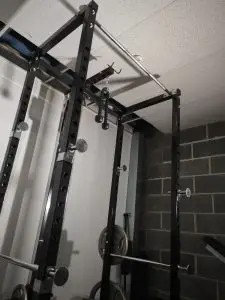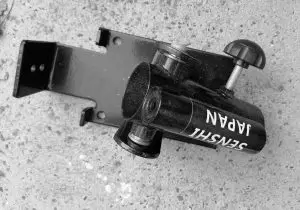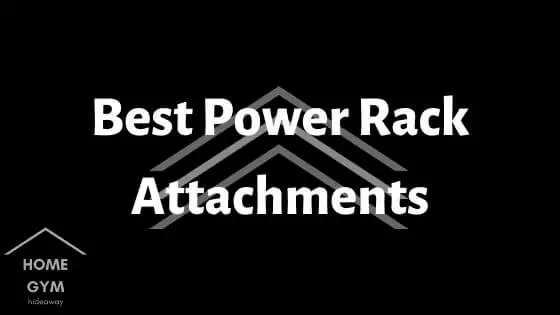A shared issue people have when making their own home gym is a shortage of space and a limited budget. Few people can get all the equipment they want and this often leads to very difficult decisions about what to purchase and what to leave out.
You can however get a full gym set up within a very small footprint and utilizing a power rack is key to this. Brands are realizing that people want their power rack to do more than just hold a barbell and this has led to some physique and strength developing attachments that also won’t break the bank.
Therefore, read on to see the best power rack attachments that will change your home gym and also your physique!
Best Power Rack Attachments
1) Pull-Up Bar

A typical piece of equipment for most home gyms is a pull-up bar. The options include doorway bars, wall-mounted pull-up bars, and power towers (freestanding) and all allow you to perform one of the best upper body exercises for strength and muscle development.
Many power racks will already come with a pull-up bar attached as standard but if you don’t have one already, look into some options that all you to use multiple grips including pronated (overhand), supinated (underhand), and neutral grips.
2) Jammer Arms

Jammer arms (or lever arms) are arguably the best power rack attachment you can currently get. It’s very close between this and a cable pulley attachment but for anyone that likes machine work and doesn’t have the space for any machines, lever arms are the solution in 2022-2023!
These relatively new attachments function as a plate-loaded, fixed movement arm allowing you to perform a variety of exercises like presses and rows that you’d otherwise need to buy specific machines for.
Related – Best jammer arm exercises for your power rack.
A jammer arm attachment transforms your power rack into a home gym or multi-gym but with the potential to use substantially more weight as a result of the plate loading system. Whenever you have the potential to use more weight, you’re more likely to get stronger and grow.
Titan currently has one of the best options on the market.
3) Lat Pulldown Attachment

While most power racks won’t come with lat pulldown or low pulley systems included, the majority of brands will have an optional pulley system for their flagship or budget power racks.
As is the case with lever arms, a lat pulldown attachment allows you to hit a variety of different muscle groups all while remaining within the footprint of the power rack.
The versatility will depend on the models available but if the lat pulldown also has a low pulley system, you can add in rows, bicep work, and cable raises in addition to the pulldowns and pushdowns that can be done on a high pulley.
** A knee pad attachment may also be needed when using heavier weights so keep this in mind when considering a Lat pulldown attachment.
4) Cable Crossover Attachment

An option that’s less universal than the lat pulldown attachment and will only be compatible with certain power racks is a cable crossover attachment. Positioned on either side of a power rack, a cable crossover attachment is a dual pulley system ideal for cable crossovers (chest flies) and delt raises.
These are definitely more space-consuming than a single pulley station and are arguably less versatile depending on the brand and weight capacities. Therefore, we’d favor a lat pulldown for most home gyms as the attachment of choice but we know people love a cable crossover so it’s good to know that it’s an option for those that want one.
5) Dip Bars
Similar to the pull-up, dips are a compound exercise for the upper body and one that almost everyone will benefit from adding to their routine.
Dip bars are therefore a great addition to a power rack. There are two types of dip bar models, one that is made up of two separate bars attached to either side of the rack on one that has both bars on the same attachment so only needs to be added to a single side of your power rack.
The latter is more space-saving and convenient however it also comes with an added cost as the fabricated material needs to be heavy-duty as it will be taking the full load of your body weight rather than distributing the load over two independent bars.
The first option is ultimately cheaper but takes up space within the power rack so you’d need to attach it and detach it each time you do this exercise. Both are a great option for adding to your power rack though.
6) Leg Press Attachment
This is currently a specialist attachment that only a few brands and manufacturers are making at present. A leg press attachment is slotted or bolted to both sides of a power rack and comes with a footplate in the center allowing you to perform leg presses.
One of the biggest drawbacks of power rack usage is that most people are limited when it comes to leg exercises. All the attachments we’ve included so far allow you to do exercises for the upper body whereas leg training is restricted to barbell movements.
Thankfully brands are coming out with options that allow you to do move leg exercises within the power rack and a leg press attachment is an excellent addition. The only drawback is that they are quite expensive at the moment and priced similar to a complete leg press machine.
Still, if you don’t have the space for a dedicated leg press machine then this attachment is a great alternative.
7) Band Pegs
Band pegs are attachments that connect to the bottom and top of the power rack and allow you to loop resistance bands around them.
When looping the bands from the bottom of the rack, you’ll then loop them around the barbell sleeves to create more tension on certain exercises like a squat or bench press. This is how most people use resistance bands but if you loop them from the top of your rack they’ll help reduce the load at the bottom of a lift which is where most people are weakest and have sticking points.
If you’ve never tried banded training then band pegs are an inexpensive way to add it into your routine.
8) Weight Plate Holders
Not performance related but when you’re training out of a power rack, chances are you’ll be short on floor space. Weight plate holders are an essential item for keeping your weight plates off the floor and stored in a convenient (and space-saving) area.
Related – How to store weights
9) J Hooks
If you’re training out of a home gym, I can almost guarantee that a barbell is one of your prized items. Barbells are the foundation of training in a power rack and properly maintaining a barbell should be high up on your priority list.
Most barbells come with a generic hook to rest the barbell on. These are typically steel and have no padding. When racking and unracking a barbell – especially with heavier weights – the metal-on-metal contact can easily damage the knurling on your bar and also ruin the paintwork on your rack.
A proper set of J-hooks with proper padding will not only protect your bar and rack from damage when racking weights but their design makes them much safer when racking the weight as well.
10) Spotter Arms
Spotter arms or safety pins are attachments that allow you to train safer when working out alone. For lifts like a bench press or barbell back squat, it can be easy to fail a lift when training close to failure or rep maxes. This is needed to push your body to change but if you fail one of these lifts without a spotter, you’ll put yourself at a very high risk of injury.
If you want to push your workouts when training solo, spotter arms can be used to drop or lower the barbell onto when you fail a rep. They allow you to still train hard without the mental restriction where you tell yourself you could get injured if you fail the lift.
Spotter arms are more heavy-duty than safety pins so make sure to check the weight load they can handle before buying a set.
See also –
How to workout without a spotter
Exercises that don’t need a spotter
Are spotter arms necessary
11) Landmine Attachment

A Landmine attachment is an unobtrusive piece of equipment that allows you to attach one end of your barbell to a fixed position while leaving the other side free to move on an axis. The key benefit to Landmine training is that it acts as a hybrid between free weight and machine training.
The use of a Landmine is good for single-arm overhead presses, single leg work, and a favorite for most, T-bar rows.
You can get a mounting Landmine like the one I have pictured above or wedge your barbell into the corner of the room from a Landmine alternative but getting a Landmine attachment for a power rack is the easiest and most space-saving option.
12) Leg Curl/Extension
As I mentioned with the leg press attachment, training legs with different exercises and movement patterns can be difficult without machines. Squats, lunges, and RDL aside, there are certain movements and muscles that you can’t work fully for the legs without machines. The legs are just too large of a muscle group and can handle some heavy weight.
A great isolation exercise that most people use is a leg extension and leg curl machine to target the quads and hamstrings. These muscles will grow when squatting, lunging, and pressing but isolation work really helps people connect with and develop their legs.
There are currently a few specialist extension/curl attachments entering the market and provide an excellent option for people to add some isolation work into their leg sessions. These aren’t refined yet but they’re still a great addition to consider.
13) Rope Anchor
Battle ropes are a popular metabolic and conditioning piece of gym equipment but they’re not the easiest to utilize in a home gym due to their length. Getting them setup is tricky for many people and we have a dedicated article on how to anchor your battle ropes in a home gym.
A rope anchor for a power rack is a very easy solution and won’t require any DIY or work needed on your property. If you currently own or want to buy battle ropes, a power rack anchor is a must.
14) Dumbbell Lift Offs
A power rack is designed for barbell training, but as you’ll see with the modifications and attachments on this list, they’re becoming much more versatile to offer a variety of training options.
Something free weight trainers might appreciate is dumbbell lift offs. If you train without a spotter, you’ll know how difficult that first rep can be for dumbbell press, especially once you work up to some noticeably heavy weight.
A flat, Incline, or overhead dumbbell press all take a considerable amount of energy to get them into position for the first rep but dumbbell lift off attachments provide a platform to easily unrack dumbbells rather than having to awkwardly hoist them into position.
If you’re pressing 110lb or heavier dumbbells then we’d recommend looking into a set of dumbbell lift offs.
15) Monolift Attachment

A monolift attachment is common in powerlifting gyms and competitions. A monolift is a barbell holder that retracts slightly once the weight is lifted (un-racked). Typically when you unrack a weight from J-hooks you need to step back with it when squatting or un-rack from a weak position on the bench press.
Both can be unsafe and also taxing in terms of energy and this ultimately impacts the effectiveness of your set.
With a monolith, you can bench press and squat safer and more efficiently when training solo without a spotter because you don’t need to “un-rack” the weight from a weak position like you do when unracking the bar normally.
This isn’t for everyone but if you’re a powerlifter or follow a powerlifting style of training you’ll definitely get a benefit from having a monolift attachment for your power rack.
16) Barbell Holder
Similar to the weight plate holder mentioned earlier, storing your gym equipment is always a difficult task because it’s not only heavy but also usually on the large side. A barbell is the perfect example of this having a relatively narrow width/diameter – but also being 7ft long for an Olympic barbell.
A barbell holding attachment allows you to store a barbell vertically for convenience and as the holder is bolted (or pegged) to the rack, it should also be held in place relatively securely.
17) Smith Machine Attachment
The final attachment we’d recommend considering for a power rack is a Smith machine attachment. These will alter your power rack functionality so I can see why this wouldn’t be for everyone but it does open up a new aspect of training without having to buy separate equipment.
Smith machines are popular pieces of equipment and allow you to do barbell movements without needing to stabilize the bar. This is because a Smith Machine moved in a fixed direction.
While these aren’t for everyone, there are a few options on the market and it can be just another addition to improve your power racks functionality.
Final Thoughts
Power racks are a deceptively versatile piece of equipment. While power racks were traditionally just used for barbell exercises, modern-day power rack attachments mean that you can hit almost every body part with genuine efficiency.
Some racks can support more attachments than others but the list we’ve compiled above is a great starting point for improving your power rack and home gym setup.
Before purchasing any items on this list, we’d also recommend checking out our article on whether or not power rack attachments are universal so that you don’t end up buying incompatible attachments.

